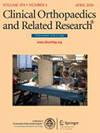Is Biportal Endoscopic Laminectomy Equivalent to Microscopic Laminectomy in Patients With Lumbar Spinal Stenosis? A Multicenter, Assessor-blind, Randomized Clinical Trial.
IF 4.4
2区 医学
Q1 ORTHOPEDICS
引用次数: 0
Abstract
BACKGROUND Lumbar spinal stenosis (LSS) impairs quality of life and is commonly treated with microscopic laminectomy. Some have suggested that biportal endoscopic laminectomy may offer advantages through smaller incisions and reduced tissue trauma. However, it remains unclear whether these theoretical advantages translate into meaningful differences in patient-reported outcomes that patients would actually perceive. QUESTIONS/PURPOSES We performed an RCT in which we asked: (1) Does biportal endoscopic laminectomy result in equivalent functional outcomes as measured by the Oswestry Disability Index (ODI) at 1 year compared with microscopic laminectomy? (2) Are pain relief, quality of life measures, and surgery-related outcomes similar between biportal endoscopic laminectomy and microscopic laminectomy? (3) Are adverse event rates comparable between the two surgical techniques? METHODS We conducted an assessor-blind RCT at six centers in South Korea. Between July 19, 2021, and April 6, 2023, a total of 120 patients with LSS were randomized to undergo biportal endoscopic laminectomy (n = 60) or microscopic laminectomy (n = 60). At 1 year, 90% (54 of 60) of patients in the biportal endoscopic laminectomy group and 86.7% (52 of 60) of patients in the microscopic laminectomy group were accounted for and fully analyzed. No crossover occurred between treatment groups, and the primary analysis followed a modified intention-to-treat approach. The baseline characteristics were well balanced between the two groups. The primary outcome was the ODI score at 12 months postoperatively. Secondary outcomes included VAS pain scores, quality of life, perioperative parameters, and adverse events, assessed at baseline, 2 weeks, and at 3, 6, and 12 months. This was an equivalence trial using the ODI as the primary outcome for sample size calculation, with an equivalence margin of ± 12.8 points, which represents the minimum clinically important difference for the ODI. RESULTS In the modified intention-to-treat analysis, we found no difference between the biportal endoscopic laminectomy and microscopic laminectomy groups in terms of ODI scores at 12 months (13 ± 12 versus 18 ± 18, mean difference -5 points [95% confidence interval -10 to 1]; p = 0.12), demonstrating equivalence between the techniques. Secondary outcomes including VAS pain scores, quality of life measures, functional recovery, satisfaction, surgical variables, and radiographic parameters were also similar between groups, with no clinically important differences observed. Adverse events were similar between biportal endoscopic laminectomy and microscopic laminectomy. CONCLUSION This study found biportal endoscopic laminectomy to be equivalent to microscopic laminectomy in functional outcomes at 12 months. However, the observed differences do not represent clinically meaningful benefits that patients would perceive. Until high-quality evidence demonstrates patient-important advantages, we recommend against the wide adoption of this technique in clinical practice. LEVEL OF EVIDENCE Level I, therapeutic study.腰椎管狭窄患者的双门静脉内窥镜椎板切除术与显微椎板切除术等效吗?多中心、评估盲、随机临床试验。
背景腰椎管狭窄(LSS)损害生活质量,通常通过显微椎板切除术治疗。一些人认为,双门静脉内窥镜椎板切除术可以提供更小的切口和减少组织创伤的优势。然而,尚不清楚这些理论上的优势是否转化为患者实际感知的患者报告结果的有意义的差异。问题/目的我们进行了一项随机对照试验,其中我们提出了以下问题:(1)与显微椎板切除术相比,双门静脉内窥镜椎板切除术在1年的Oswestry残疾指数(ODI)测量中是否具有相同的功能结果?(2)双门静脉内窥镜椎板切除术和显微椎板切除术在疼痛缓解、生活质量措施和手术相关结果方面是否相似?(3)两种手术方式的不良事件发生率是否具有可比性?方法:我们在韩国的6个中心进行了一项评估盲随机对照试验。在2021年7月19日至2023年4月6日期间,共有120例LSS患者随机接受双门静脉内镜椎板切除术(n = 60)或显微椎板切除术(n = 60)。1年时,90%(54 / 60)的双门静脉内窥镜椎板切除术组患者和86.7%(52 / 60)的显微椎板切除术组患者被统计并充分分析。治疗组之间未发生交叉,初步分析采用改良的意向治疗方法。两组之间的基线特征很好地平衡。主要观察指标为术后12个月ODI评分。次要结局包括VAS疼痛评分、生活质量、围手术期参数和不良事件,分别在基线、2周、3、6和12个月进行评估。这是一项使用ODI作为样本量计算的主要结局的等效试验,等效裕度为±12.8点,这代表了ODI的最小临床重要差异。结果在改进的意向治疗分析中,我们发现双门静脉内窥镜椎板切除术组和显微椎板切除术组在12个月的ODI评分方面没有差异(13±12比18±18,平均差-5分[95%可信区间-10到1];p = 0.12),表明两种技术之间是等效的。次要结果包括VAS疼痛评分、生活质量测量、功能恢复、满意度、手术变量和影像学参数在两组之间也相似,没有观察到临床上重要的差异。双门静脉内窥镜椎板切除术与显微椎板切除术的不良事件相似。结论:本研究发现,在12个月的功能预后方面,双门静脉内窥镜椎板切除术与显微椎板切除术相当。然而,观察到的差异并不代表患者会感知到的有临床意义的益处。在高质量的证据证明对患者重要的优势之前,我们不建议在临床实践中广泛采用该技术。证据水平:I级,治疗性研究。
本文章由计算机程序翻译,如有差异,请以英文原文为准。
求助全文
约1分钟内获得全文
求助全文
来源期刊
CiteScore
7.00
自引率
11.90%
发文量
722
审稿时长
2.5 months
期刊介绍:
Clinical Orthopaedics and Related Research® is a leading peer-reviewed journal devoted to the dissemination of new and important orthopaedic knowledge.
CORR® brings readers the latest clinical and basic research, along with columns, commentaries, and interviews with authors.

 求助内容:
求助内容: 应助结果提醒方式:
应助结果提醒方式:


